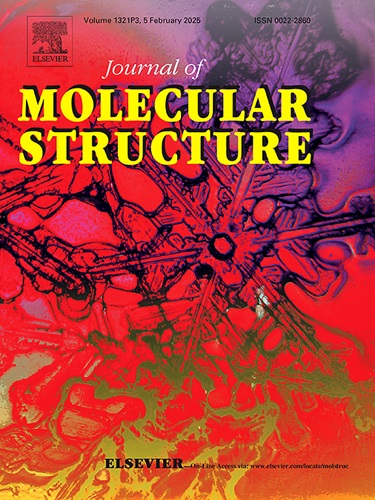Synergistic broad-spectrum bioactivity of some multifunctional novel Anil metal chelates: Design, synthesise, nonlinear optical properties, and biomedical applications supported by DFT and molecular docking insights
IF 4
2区 化学
Q2 CHEMISTRY, PHYSICAL
引用次数: 0
Abstract
Novel tetra-dentate BSAB imine ligand and its Fe(III), Cu(II), Zn(II), and Ru(III) chelates were synthesised. Elemental analysis (CHN), conductivity, electromagnetic susceptibility, spectroscopy (IR, nuclear magnetic resonance (masses spectrometer), ultraviolet-visible spectra studies, and theoretical investigations were employed to ascertain structural formulas of the ligand's and its synthesized chelates. The metal chelates of Fe(III), Cu(II), Zn(II), and Ru(III) showed an octahedral geometry with NNOO coordination mode of its BSAB ligand. Stoichiometry determination in solution using Job’s method reveals that 1:1 metal-to-ligand ratio in these formations. The complexes under investigation are stable throughout a broad pH range, usually around 4 and pH = 10, according to the pH profile. The B3LYP level, B3LYP/6-311G(d,p) level for the free ligand (BSAB), and B3LYP/6–311G(d,p)-LANL2DZ functional level for the solid chelates of Cu, Fe, Ru, and Zn were used in density functional theory (DFT) calculations. The results showed that the DFT calculations were consistent with the experimental ones. The study scrutinized the nonlinear optical characteristics of the synthesized materials to uncover and enhance their exceptional optical properties. The antimicrobial efficacy of these compounds was empirically validated through the implementation of the agar well diffusion technique, showcasing their potency. Moreover, hepatic cellular carcinoma cells, breast carcinoma cells, and colon cancer cells were used to test the in vitro anticancer properties of the BSAB ligand and its complexes. Considering the IC50 values, the order of effectiveness was fond as follows: BSAB < BSABFe < BSABZn < BSABCu < BSABRu, across the MCF-7 (breast cancer), Hep-G2 (hepatocellular carcinoma), and HCT-116 (colon cancer) cell lines. Additionally, the compounds' capacity to inhibit the radical DPPH was investigated. Furthermore, molecular landing models were run to ascertain whether the generated compounds were bound to the particular protein-bound locations.

一些多功能新型Anil金属螯合物的协同广谱生物活性:设计、合成、非线性光学性质以及DFT和分子对接见解支持的生物医学应用
合成了新型四齿BSAB亚胺配体及其Fe(III)、Cu(II)、Zn(II)、Ru(III)螯合物。采用元素分析(CHN)、电导率、电磁磁化率、光谱(IR)、核磁共振(质谱)、紫外可见光谱研究和理论研究确定了配体及其合成的螯合物的结构式。金属螯合物Fe(III)、Cu(II)、Zn(II)和Ru(III)呈八面体结构,其BSAB配体具有NNOO配位模式。用Job的方法在溶液中进行化学计量测定,发现这些结构中金属与配体的比例为1:1。所研究的配合物在很宽的pH范围内是稳定的,根据pH值分布,通常在4和pH = 10左右。B3LYP水平、B3LYP/6-311G(d,p)水平用于自由配体(BSAB), B3LYP/6-311G(d,p) -LANL2DZ功能水平用于Cu、Fe、Ru和Zn固体螯合物的密度泛函理论(DFT)计算。结果表明,DFT计算结果与实验结果吻合较好。该研究仔细研究了合成材料的非线性光学特性,以揭示和增强其特殊的光学特性。通过琼脂孔扩散技术的实施,这些化合物的抗菌功效得到了经验验证,显示了它们的效力。此外,我们还利用肝癌细胞、乳腺癌细胞和结肠癌细胞来检测BSAB配体及其复合物的体外抗癌特性。考虑到IC50值,效果排序为:BSAB <;BSABFe & lt;BSABZn & lt;BSABCu & lt;BSABRu,横跨MCF-7(乳腺癌),Hep-G2(肝细胞癌)和HCT-116(结肠癌)细胞系。此外,还研究了化合物对自由基DPPH的抑制能力。此外,运行分子着陆模型以确定生成的化合物是否结合到特定的蛋白质结合位置。
本文章由计算机程序翻译,如有差异,请以英文原文为准。
求助全文
约1分钟内获得全文
求助全文
来源期刊

Journal of Molecular Structure
化学-物理化学
CiteScore
7.10
自引率
15.80%
发文量
2384
审稿时长
45 days
期刊介绍:
The Journal of Molecular Structure is dedicated to the publication of full-length articles and review papers, providing important new structural information on all types of chemical species including:
• Stable and unstable molecules in all types of environments (vapour, molecular beam, liquid, solution, liquid crystal, solid state, matrix-isolated, surface-absorbed etc.)
• Chemical intermediates
• Molecules in excited states
• Biological molecules
• Polymers.
The methods used may include any combination of spectroscopic and non-spectroscopic techniques, for example:
• Infrared spectroscopy (mid, far, near)
• Raman spectroscopy and non-linear Raman methods (CARS, etc.)
• Electronic absorption spectroscopy
• Optical rotatory dispersion and circular dichroism
• Fluorescence and phosphorescence techniques
• Electron spectroscopies (PES, XPS), EXAFS, etc.
• Microwave spectroscopy
• Electron diffraction
• NMR and ESR spectroscopies
• Mössbauer spectroscopy
• X-ray crystallography
• Charge Density Analyses
• Computational Studies (supplementing experimental methods)
We encourage publications combining theoretical and experimental approaches. The structural insights gained by the studies should be correlated with the properties, activity and/ or reactivity of the molecule under investigation and the relevance of this molecule and its implications should be discussed.
 求助内容:
求助内容: 应助结果提醒方式:
应助结果提醒方式:


